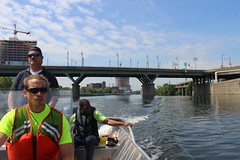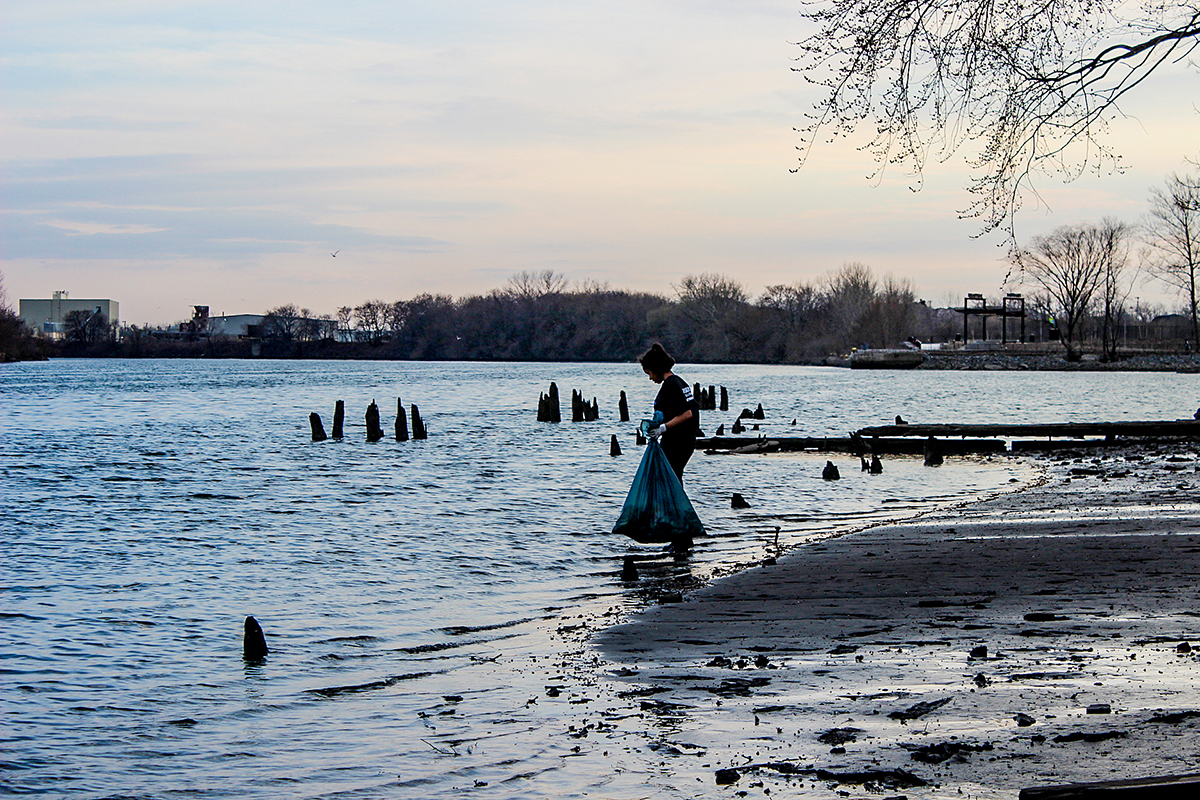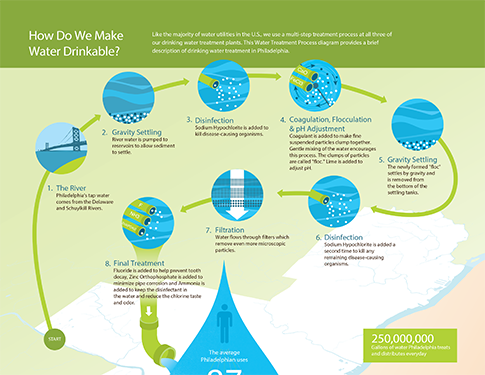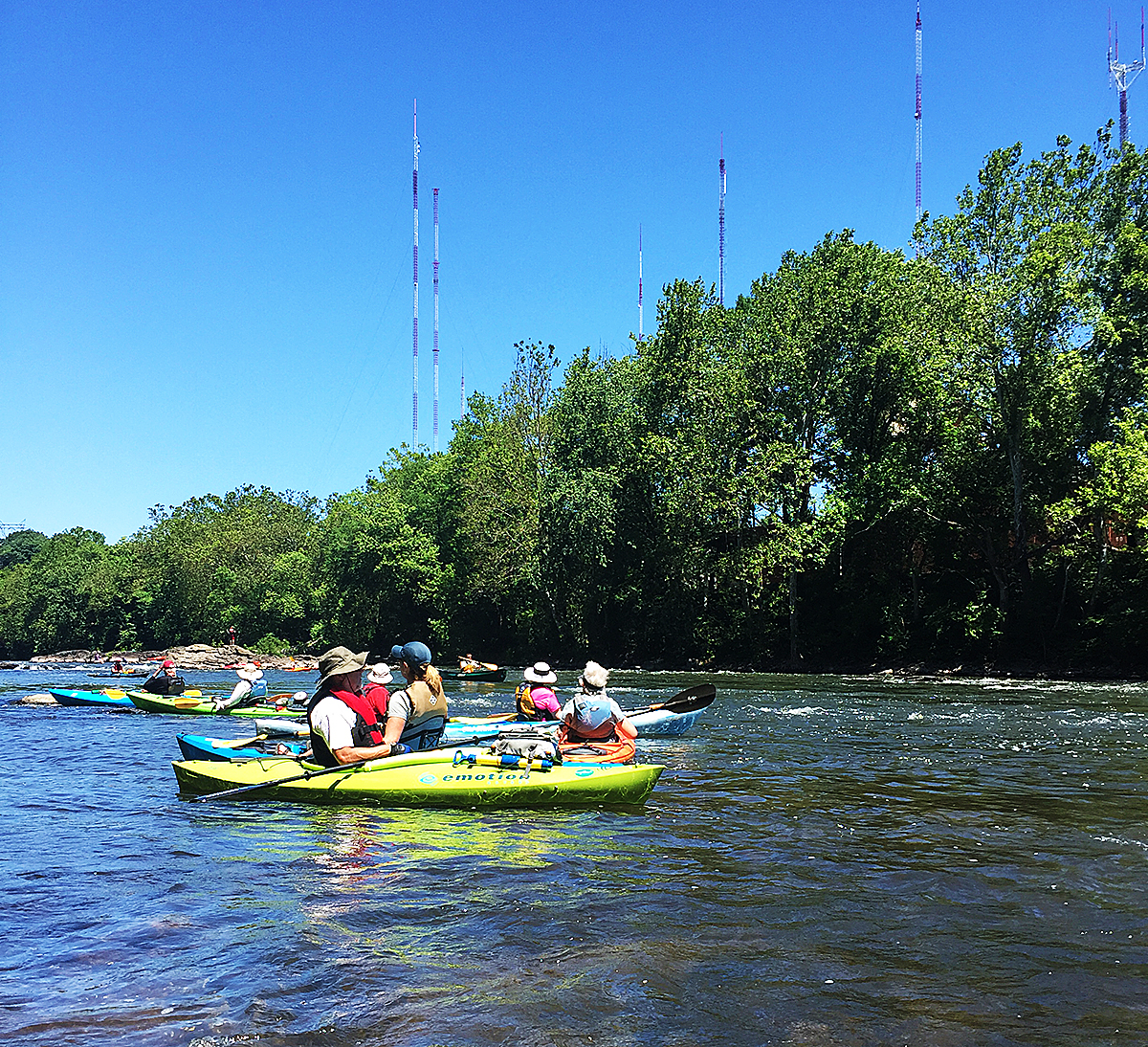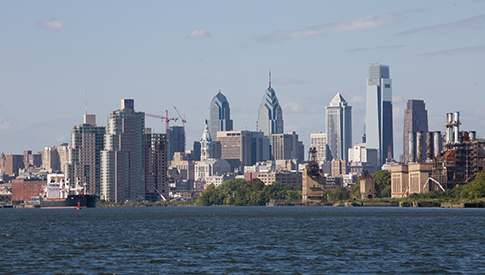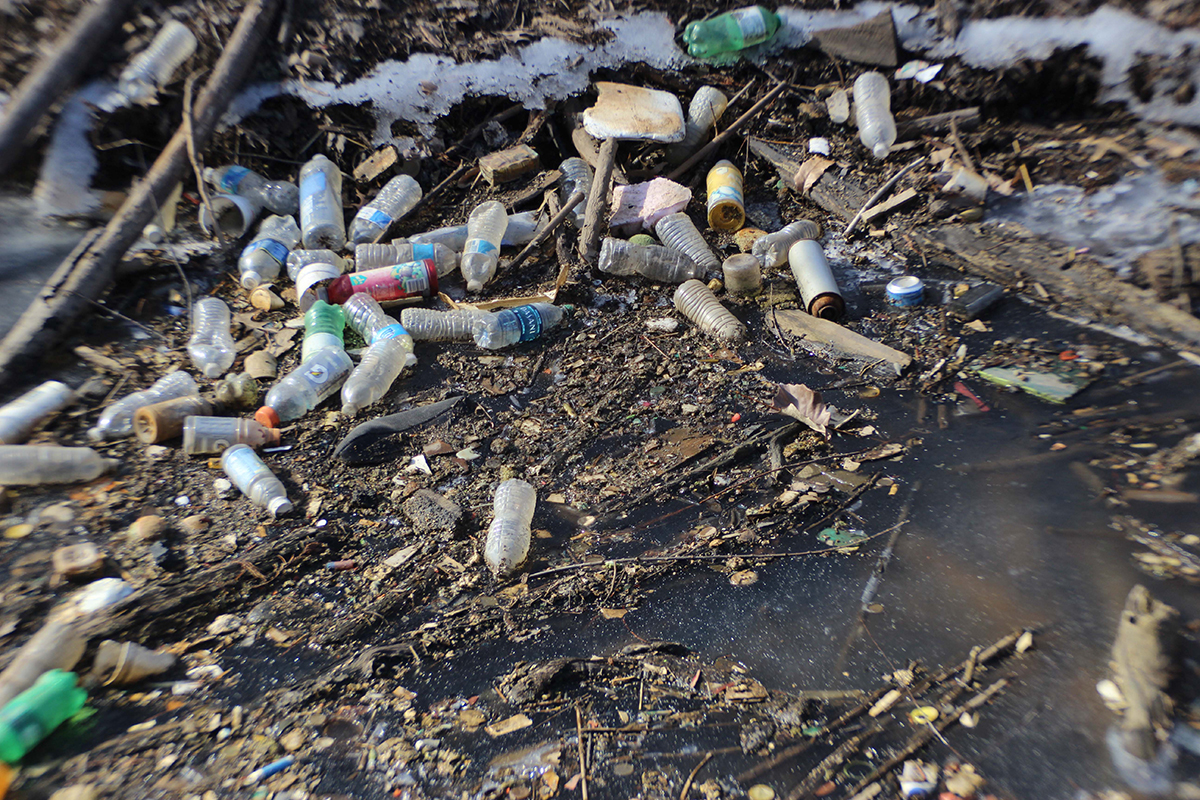
Left to Right: Lance Butler, Dimitri Forte, Declan Patterson, and Richard Anthes. Philadelphia Water’s Watersheds Field Services Group deploys a fleet of three small boats to reach trash in waterways that others can’t. Credit: Brian Rademaekers.
During a typical litter-hunting trip in early June, Philadelphia Water’s Lance Butler was operating the department’s new 20-foot workboat along the banks of the Schuylkill River just below the Fairmount Water Works. Edging the bow of the craft just close enough to the rocky embankment, Butler made it possible for his three crew members to scoop up the otherwise unreachable trash that peppered the water and shoreline.
This was the workboat’s maiden voyage, and it was already proving to be an invaluable tool in the department’s fight against floating litter.
The activity attracted the attention of a young man sitting on a nearby bench. Within a few minutes, he approached the boat and asked Butler a question—could he have a trash bag?
“What for?” Butler asked.
“To pick up trash,” the man replied. “It’s such a beautiful park.”
An hour later, Butler and his crew—referred to within department as the “Watersheds Field Services Group,” and, less formally, as “the skimming guys”—were on the opposite side of the river, their boat growing ever-more crowded with bags containing the typical flotsam of plastic bottles and bags, Styrofoam cups and other debris that had washed into the breathtaking waters below Fairmount Dam.
On the other side of the river, the spontaneous volunteer was still at it, his bag of litter now bulging to the point of overflowing.
“That guy,” Butler said, “is amazing.”
Keeping Our Waters Clean
That guy also wasn’t alone in noticing the Philadelphia Water staff and the long, polished workboat, which has a large blue-and-white decal along each side proclaiming the craft’s mission: “Keeping Our Waters Clean.”
With the day warm enough for sunbathing on the lawn of the Schuylkill Banks park, many people were out enjoying the river’s beauty and taking advantage of the nearby trails—and many people stopped to wave at the crew, thanking them now and then for keeping the waters clean.
Butler, an aquatic biologist and manager of Philadelphia Water’s Environmental Restoration & Maintenance Program, was joined on the water that day by Declan Patterson, a Drexel University student working with the Office of Watersheds through a co-op program; Dimitri Forte, with the Watershed Field Services Group; and Richard Anthes Jr., an environmental scientist with the Office of Watersheds’ Ecological Restoration Group.
By the end of the day, the workboat, which had launched at 9 a.m. sharp from Fort Mifflin, near the confluence of the Schuylkill and Delaware Rivers, was packed with full 55-gallon trash cans and overstuffed clear plastic trash bags, the collected litter sorted into recyclable and non-recyclable items.

One of six 55-gallon trash cans of litter pulled from the Schuylkill River during the maiden voyage of Philadelphia Water's new workboat. Much of the trash is plastic water bottles. Credit: Brian Rademaekers
While impressive, the haul of 210 pounds was standard for a day on the river. Similar collections take place about two to three times per week, March through October, on the tidal sections of Delaware and Schuylkill. Further upstream, a 22-foot pontoon-style skimmer boat takes on trash in the shallower waters during weekly trips.
Last year, the pontoon vessel alone removed nearly four tons—that’s 8,000 pounds and 10 full Dumpsters—of this type of trash from Philly’s riverbanks and waterways.
A third boat, the 32-foot R.E. Roy, also helps to (among other things) keep trash at bay, collecting 29,000 pounds of trash from our large tidal rivers in 2015.
So far in 2016, Philadelphia Water boats have collected 4.8 tons of trash during 72 trips (50 days on the Schuylkill and 22 on the Delaware). Among the trash collected, recyclables accounted for over 40 percent of the weight, or nearly 2 tons.
All of this is done under Philadelphia Water’s little known but important Marine Debris and Floatables Management Program. Understandably, many people don’t think of litter collection when they think of work done by their water department.
In reality, the Marine Debris and Floatables Management Program is built into the regulations and permits that allow Philadelphia Water to maintain a vast network of stormwater and sanitary sewers, waste treatment plants, and more.
The Fight Against ‘Floatables’
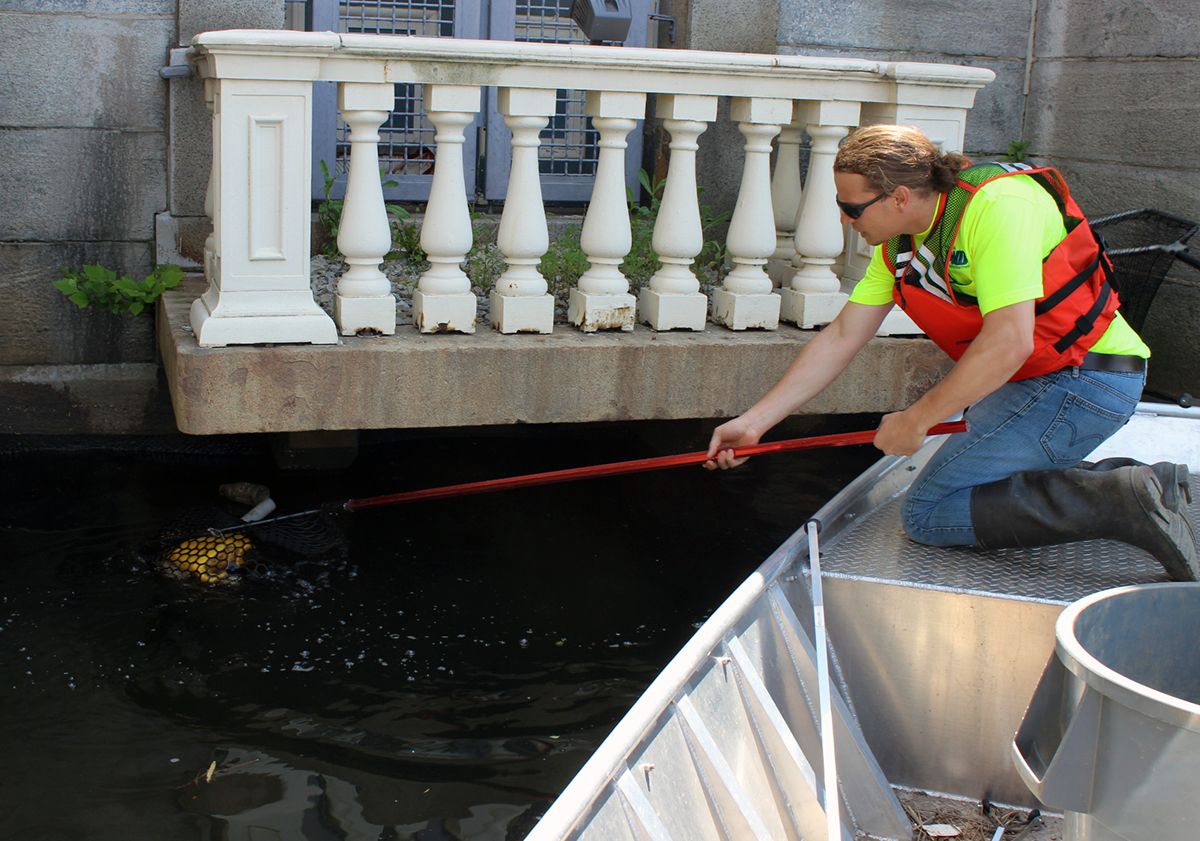
Rick Anthes skims the water by the Fairmount Water Works, collecting hard to reach trash from the Schuylkill River. Credit: Brian Rademaekers
If you haven’t heard the term “floatables” before, think of the trash like plastic bottles, cigarette butts, plastic bags and discarded wrappers that you likely see on city streets every day. Up there, it’s just your run of the mill (depressing) litter. Once rain washes this buoyant stuff into our waterways, it gets categorized as floatables.
Because floatables can sometimes find their way into rivers and creeks by travelling through one of Philly’s 75,000+ storm drains first, controlling this trash is considered to be a part of combined sewer system maintenance for Philadelphia and other cities, like New York.
For the same reason, combined sewer outfalls—places where combined sewer pipes empty into waterways—can be floatables hotspots and are often targeted by Philadelphia Water boats during trash skimming patrols.
The boats play an important role in a much bigger effort to remove litter and other debris from our waterways, an effort that includes work ranging from inspections done by our Inlet Cleaning crews, which hit about 275 storm drains each day, to the heavy lifting of the Waterways Restoration Team, which removes “trash” as big as abandoned cars while doing tasks like repairing eroded streambanks.
Outside of Philadelphia Water, volunteer cleanups play a huge role, engaging citizens in watershed stewardship and extracting mind-boggling volumes of trash annually.
For example, Keep Pennsylvania Beautiful reported a total of nearly 1.3 million pounds of trash removed by 29,259 volunteers during 1,003 cleanups along the Schuylkill River in 2015. Those figures include volunteer events like the popular Schuylkill Scrub, organized by the Schuylkill Action Network, and tally trash collected from the headwaters to all the way down to Philadelphia.
Thank you to all the #volunteers who joined us to clean up the #DelawareRiver! #CleanWatersPHL https://t.co/iLYwyrtiw7
— Philadelphia Water (@PhillyH2O) July 15, 2016
Public-private partnerships, like the United By Blue (UBB) volunteer events(Sorry, this content is no longer available) sponsored in part by Philadelphia Water, also help to chip away at the problem. UBB events along Philadelphia waterways have collected 25,657 pounds of trash so far in 2016.
This August, the nationally-acclaimed Living Lands and Waters organization is returning to Philadelphia for a second round of cleanups after collecting close to 33,000 pounds of trash along the Delaware and Schuylkill last summer. You can sign up now if you want to give a hand.(Sorry, this content is no longer available)
Join #ChadPregracke & @LLandW to clean up the Delaware River this Aug. https://t.co/VhyYSmPEUm #EstuaryCollaboration https://t.co/vTSdTK5NYd
— Delaware Estuary (@DelawareEstuary) June 21, 2016
A Special Tool
While those efforts are invaluable, Philadelphia Water’s floatables fleet does something most volunteers can’t: reach the inaccessible nooks and crannies along steep banks and other places people can’t walk to, but often harbor lots and lots of trash. The “skimming guys” also live up to their name, literally skimming the water with large rubber nets designed to capture even small bits of litter like broken-down Styrofoam.
In addition to assisting the Watersheds Field Services Group’s “floatable” litter removal efforts, the boats also allow Philadelphia Water to do tasks including surveying river and infrastructure conditions, aquatic life studies, water quality assessments, wetland surveys and bathymetric profiling of the rivers’ bottoms.
Butler, who relies heavily on certified boat operators, such as Jim D’Agostino, to pilot the floatables collection trips, says the litter pulled from our waterways isn’t just ugly; it can do real harm both directly and indirectly to the aquatic and semiaquatic fauna residing within Philadelphia’s Watersheds.
“Macroplastics and other submersible marine debris have been shown to ‘smother’ benthic habitats and have also been directly ingested by both aquatic and terrestrial fauna mistaking the debris as food,” says Butler. “The decomposition of plastic material to particle size, known as microplastics, have also been shown to be present in the digestive systems of many fish and bird species.”
(For a glimpse at the sort of issues that have scientists concerned about the abundance of plastic in our waterways, read this report from the BBC.)
Getting to the Root of the Problem
The work of the skimming boats, the Inlet Cleaning Crews, the Waterways Restoration Team and the many volunteers mentioned above—it’s all aimed at one big task: getting litter out of our waterways and off our waterfronts. Filling up a few Dumpsters with a bunch of trash that was just making your favorite local waterway look bad? That’s always rewarding.
But, as anyone who’s done this work can tell you, it’s never enough. And there’s always a sense that it won’t be long before more litter shows up.
The hard truth is, unless our neighborhoods and streets are litter free, our rivers and creeks won’t be either.
In addition to helping with the cleanups listed on our calendar and elsewhere, you can help by working with the Streets Department’s Pick It Up, Philly! campaign, Keep Philadelphia Beautiful, and your local community group.
You can also help cut waste by doing things like choosing reusable water bottles and encouraging others to do the same—tell your friends, kids and neighbors that cleaner streets mean cleaner rivers and creeks.
And, if you see a boat full of people scooping trash out of the river the next time you take a jog down the Schuylkill River Trail, now you’ll know: that’s probably Philadelphia Water, working to keep our waters clean.
See more photos of the workboat in action:

